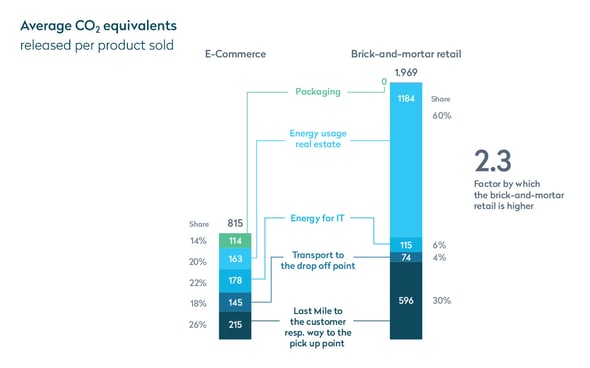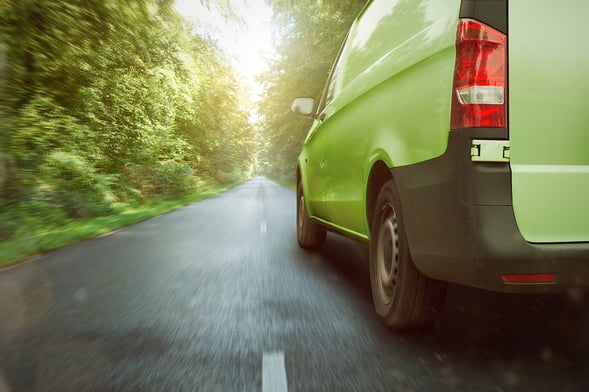Corporate responsibility and sustainability are key focus areas for businesses worldwide. An exclusive study recently published by Seven Senders outlines areas where online retailers have the greatest potential for reducing their carbon footprint. It also shares insight on consumer perspectives and their expectations for e-tailers to do their part to protect the planet.
Roadmap 2025: Sustainability in European e-commerce brings together the latest research findings and consumer attitudes regarding sustainability and e-commerce. Along with examples of best practices within the e-commerce industry, the study features the results of a consumer survey carried out by market research institute Appinio of 3,500 online shoppers in Germany, France, Italy, the Netherlands, Austria, Spain, and Switzerland. The study aims to help online retailers identify and implement ways to improve their impact on the environment.
Online retail boom equals increased shipping, traffic, and production
Growth has been occurring in the online shopping sector for several years, and that trend was fueled by the pandemic, leading to significant increases in cross-border shipments throughout the EU. According to a 2020 survey, 22 percent of total B2C sales in 15 major European e-commerce markets came from cross-border retail1. In 2021, cross-border online retail in Europe grew by a further 17 percent to a total volume of EUR 171 billion2.
The production of this growing volume of goods is responsible for the majority of the greenhouse gasses emitted over the product life cycle. In fact, despite its growth, online retail has a lower impact on traffic and vehicle emissions than traditional retail.
The graphic below illustrates the difference in CO2 equivalents released per product sold between e-commerce and brick and mortar retail businesses:
 Image Source: Oliver Wyman, “Is E-Commerce good for Europe?”, Economic and environmental impact study, p. 64
Image Source: Oliver Wyman, “Is E-Commerce good for Europe?”, Economic and environmental impact study, p. 64
If you consider all the individual contributions from the whole supply chain – from storage to sales, packaging, and transporting the goods to the customer’s home – separated according to trade route and product type, the findings are unanimous. In more than 80 percent of cases, online retail has an environmental advantage over brick-and-mortar retail3.
Another factor of online retail that improves eco-balance is that many online stores take advantage of centralized or shared warehouses to store their products. One large warehouse storing products for 100 online shops uses considerably less energy and has fewer negative environmental impacts than if 100 stores individually stored their goods in smaller facilities.

Strategies for reducing environmental impact of online retail
As they grow, most online retailers have recognized the cost savings and waste reduction that can come from reducing packaging and using reusable and recyclable packaging concepts. Movements to eliminate single-use plastic packaging and to create multi-use shipping bags are proving not only to be less expensive but also more palatable to customers.
E-tailers are also rethinking the origin of the goods they sell and the transportation methods they use to receive them. Buying products from Asia that ship by air produces 25 times more CO2 than products bought in bulk and shipped by sea to be stored in a consolidated warehouse in the EU4.
While the first mile costs can be managed with bulk shipments, it’s often the last mile – to a single consumer – that makes the largest environmental impact and where significant improvements can be made.
Last mile options that can save on emissions include electric vehicles, bicycle messengers, or centralized delivery lockers where customers can retrieve their purchases. Digital planning tools have been created and are being improved specifically to focus on reducing environmental impacts.
Communication is key to more sustainability
One best practice for environmentally responsible online stores is focusing on clear and accurate product information and sizing. This dramatically reduces returns, which can make up as much as 25 percent of the emissions within the transportation life cycle.
Communicating options is also helpful. When customers understand the environmental benefit of the delivery options available (such as picking their packages up at a centralized location), twice as many will opt to do so. Sustainable options get chosen more when communicated clearly, often with visual indicators like a green leaf.
Offsetting: a valuable step in becoming more sustainable now
One approach for online retailers to reduce their environmental impact is via the offsetting of transport-related carbon emissions. This alternative builds a “golden bridge” for what e-tailers can be doing right now until even lower-emission delivery process are available in the future. Seven Senders has developed a method for the e-commerce industry to facilitate offsetting cross-border shipments. It was certified by DEKRA in 2021 and comprises three components:
1. Calculating the first mile – The logistics service provider knows the specific transport routes and the precise distance a product travels from the sender to the recipient. And for each transportation stage, it knows how many pallets were loaded into which type of vehicle and how they are allocated to each customer. Based on this data, the carbon emissions of each transport route can be calculated, and then the CO2 figure can be broken down into the number of pallets transported for each specific customer.
2. Calculating the line haul of the last mile carrier – The second step is to calculate the carbon emissions of the next line, from the hub to the local depot. Here the number of kilograms transported is also factored into the CO2 calculation: the heavier the parcel is and the further it is being transported, the higher the carbon emissions.
3. Calculating the last mile – on the last leg to the end customer, sustainability depends on whether the package is delivered to a PUDO locator or to the customer's home address. Thus, carbon emissions for the last mile delivery are calculated and added to the other two stages. Once the emission calculations are complete, e-tailers can “offset” those emissions via certified climate protection projects.
Where the potential lies…
As the study shows, customer interest in sustainable consumption has never been greater, and their willingness to pay more for this is increasing, too. 90 percent of 18–24-year-olds, Generation Z, now say that all companies should make a positive social contribution and take responsibility for protecting our environment5. Considering the majority of online shops do not offer a sustainable shipping method at checkout, e-tailers can benefit from making sustainability part of their business model.
Endnotes:
1. Belgien, Frankreich, Deutschland, Irland, Niederlande, Vereinigtes Königreich, Dänemark, Finnland, Norwegen, Schweden, Österreich, Schweiz, Italien, Portugal und Spanien; in: Cross-Border Commerce Europe (2021). Top 16 Cross-Border EU Countries 2021 (https://www.cbcommerce.eu/product/top-16-cross-border-eu-countries/).
2. Cross-Border CBCOMMERCE.EU: Study Top 500 Cross-Border Retail Europe 2022 (Issue 4)
3. Die Ökologisierung des Onlinehandels. 2020. S. 27. https://www.umweltbundesamt.de/sites/default/files/medien/5750/publikationen/2020_12_03_texte_227-2020_online-handel.pdf
4. Oliver Wyman: Report; is e-commerce good for Europe, 2020, p. 9
5. The influence of ‘woke’ consumers on fashion, McKinsey & Company, February 2019

